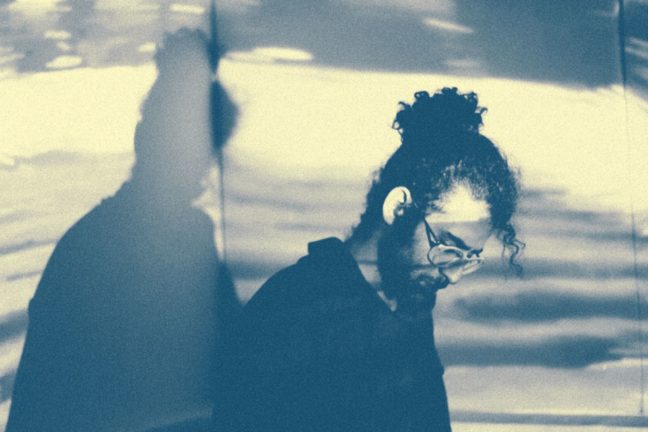Arash Azadi is a young Iranian composer based in Yerevan, a multidisciplinary artist and art director whose works are influenced by creative technologies. Born in Hamedan, Iran, 1994, Azadi began studying classical Persian setar at the age of nine. In 2012, he enrolled in Armenia’s Yerevan State Conservatory, where he majored in composition and began mastering the ins and outs of the visual programming language Max/MSP through an online course offered by the Massachusetts College of Art. His most recent works fall under the umbrella of electroacoustic and experimental music and are often accompanied by audio-visual effects, performance art or improvised dance and theatre. With a background in maths and computer sciences, Azadi has also explored ways to combine modern approaches to sound with acoustic and folk music. To date, his works have been performed in France, Italy, Germany, and Greece in addition to his native and temporary homelands of Iran and Armenia.
Where are you currently located and can you describe your surroundings?
At the moment, I’m in Iran visiting my family and also sorting out my military service status, trying to get freed from the obligatory military service. But I’m permanently based in Yerevan, Armenia. While I’m here, we are traveling between Tehran and other cities with my partner, who came here from Armenia to discover the local art scene.
You were born in Hamedan, Iran, and studied classical Persian setar from an early age. Can you talk about the environment and the context you grew up in?
Hamedan is an old small city with very traditional people. I grew up listening to traditional music in our house, my father’s car, and also listening to my father play Tar. As a kid I wanted to learn guitar but being under pressure from my family and siblings I chose the setar to begin my musical journey.
After entering school for exceptional talent I got interested in programming and 3d animation more, which brought me to the world of game development. It was then that I discovered electronic music and production software. At the same time, my family was pushing me to leave music behind and focus on game development. But their efforts didn’t have any effect, as I was already spending most of my time trying to compose music on my computer.
Eventually you moved to Armenia and studied composition and mastering. Can you talk about these two cultural milieus, and their impact on your work and your role in them?
From the very beginning, I felt like at home in Armenia because of the cultural similarities. Having background in traditional music, I soon got interested in Armenian folk and church music. That interest got more developed during my studies at the conservatory, as many teachers had been insisting on researching and using traditional music in our compositions. As a result, you can feel an influence of folk music in my compositions – sometimes it’s obvious and bold, sometimes subtle.
Would you say that you work as a composer with a score, rather than a soloist producer?
I entered the music world as an instrumentalist, so I thought of sound as one produced by a human. So for me the relationship of a composer and the realized piece used to be indirect, mediated by musicians. This is why I’m obsessed with scoring. By scoring I don’t always mean traditional notation – it can be anything that you put on paper, graphics, words, anything that creates that connection between me and the musician. And in the world of electronic music or gallery based installations, where you don’t need notation, there is a direct relationship between your ideas and instruments. But I still try to have a sort of a score to get an overall picture of my narration. Having said this, my favourite orchestrations are those that include human and non-human interactions. For example, pieces for acoustic music ensembles and electronics or robots.
What role does technology and an analytical/mathematical approach play in your work?
As I think of technology as a tool to extend human abilities to transcend, it has always had a big impact on me and my art from the very beginning. As any kid of 90s, I used to always play with cassette players and microphones recording over my parents’ records. Later at school I was involved in programming, 3d animation, robotics. Things I learned stayed with me until now and can be seen in my generative art design for installations and audiovisual performances.
As for mathematics, it has been my second passion after music. I have different approaches towards mathematics in arts that is applied in different ways. Sometimes directly by using mathematical equations or series, and sometimes through math logic.
One of your pieces is called: “From Past-Present-Future to Freedom”, is this meant in a purely aesthetical sense of the word (freedom through musical experimentation), or can you work be viewed in a wider, socio-political context?
The piece is based on several linguistic researches I was doing before writing a piece on the philosophy of language as a framework of thought and language as a symbolic representation of history. Taking music as a language to express we can think of this language in a time-based platform. This is why I have used several musical elements that are directly borrowed from traditional music like drones based on 4th and 5th intervals, samples from Armenian church songs (Sharakan), folk music and field recordings from historical places in Armenia. The present is represented by musicians and the future comes in through electronic sounds and noises.
Now, regarding the main question. As the audience gets engaged with the piece, eventually language and time dissolve into abstraction and that’s where freedom can be found. And I see this liberation from the power of history and language, as they are not separable, as a socio-political message.
